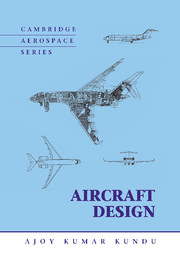Book contents
- Frontmatter
- Contents
- List of Symbols and Abbreviations
- Preface
- Road Map of the Book
- 1 Introduction
- 2 Methodology to Aircraft Design, Market Survey, and Airworthiness
- 3 Aerodynamic Considerations
- 4 Aircraft Classification, Statistics, and Choices for Configuration
- 5 Aircraft Load
- 6 Configuring Aircraft
- 7 Undercarriage
- 8 Aircraft Weight and Center of Gravity Estimation
- 9 Aircraft Drag
- 10 Aircraft Power Plant and Integration
- 11 Aircraft Sizing, Engine Matching, and Variant Derivative
- 12 Stability Considerations Affecting Aircraft Configuration
- 13 Aircraft Performance
- 14 Computational Fluid Dynamics
- 15 Miscellaneous Design Considerations
- 16 Aircraft Cost Considerations
- 17 Aircraft Manufacturing Considerations
- Appendix A Conversion
- Appendix B International Standard Atmosphere
- Appendix C Aerofoils
- Appendix D Case Studies
- Appendix E Tire Data
- References
- Index
13 - Aircraft Performance
Published online by Cambridge University Press: 05 June 2012
- Frontmatter
- Contents
- List of Symbols and Abbreviations
- Preface
- Road Map of the Book
- 1 Introduction
- 2 Methodology to Aircraft Design, Market Survey, and Airworthiness
- 3 Aerodynamic Considerations
- 4 Aircraft Classification, Statistics, and Choices for Configuration
- 5 Aircraft Load
- 6 Configuring Aircraft
- 7 Undercarriage
- 8 Aircraft Weight and Center of Gravity Estimation
- 9 Aircraft Drag
- 10 Aircraft Power Plant and Integration
- 11 Aircraft Sizing, Engine Matching, and Variant Derivative
- 12 Stability Considerations Affecting Aircraft Configuration
- 13 Aircraft Performance
- 14 Computational Fluid Dynamics
- 15 Miscellaneous Design Considerations
- 16 Aircraft Cost Considerations
- 17 Aircraft Manufacturing Considerations
- Appendix A Conversion
- Appendix B International Standard Atmosphere
- Appendix C Aerofoils
- Appendix D Case Studies
- Appendix E Tire Data
- References
- Index
Summary
Overview
This chapter assesses whether the aircraft being configured, thus far, meets the FAR and customer requirements given in the form of specifications. Coursework follows linearly from the mock market survey (see Chapter 2). Specification requirements addressed in this chapter include aircraft performance to meet the (1) TOFL, (2) LFL, (3) initial rate of climb, (4) maximum speed at initial cruise (especially for civil aircraft design), and (5) payload range. Chapter 16 computes the aircraft DOC, which should follow the aircraft performance estimation.
Aircraft performance is a subject that aeronautical schools offer as a separate course. Therefore, to substantiate the FAR and customer requirements, this chapter addresses only what is required – that is, the related governing equations and computational examples associated with the five substantiation parameters listed previously. Substantiation of the payload range requires integrated performances of climb and descent that show fuel consumed, distance covered, and time taken for the flight segments. Integrated climb and descent performances are not specification requirements at this stage; therefore, their detailed computational examples are not provided. Instead, the final results in graphical form carry out the payload-range estimation. It is suggested that readers refer to appropriate textbooks for details on this topic. The turboprop example is not worked out but there is sufficient information to compute it similarly.
The remainder of the book after this chapter (except Chapter 16) presents information that aircraft designers should know and apply to their configurations.
- Type
- Chapter
- Information
- Aircraft Design , pp. 417 - 463Publisher: Cambridge University PressPrint publication year: 2010
- 1
- Cited by



